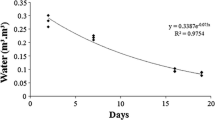Abstract
Crown architecture was analyzed forScaphium macropodum (Sterculiaceae), a common shade-tolerant emergent tree of a tropical rain forest in West Kalimantan, Indonesia. Saplings and poles shorter than 12 m in height had no branches, and gathered their leaves at the ends of the stem. The leaves changed from entire to palmately-parted with increasing tree size. The parted leaves increased the light penetration through the clustered foliage. The size of leaves including the blade and petiole ranged from 22 cm to 147 cm. Because the weight of petiole per blade increased with leaf size, the leaf could not be enlarged infinitely. Taller trees with lateral branches bore small (about 40 cm in length) entire leaves. The light intensity in the forest increased from the ground to about 12 m tall and was nearly constant from 12 m to 18 m. Crown architecture ofS. macropodum adapted to this light environment. The monoaxial trees lower than 12 m could thus increase the amount of light with vertical elongation, and the branched trees higher than 12 m could increase it by means of lateral extension of crown area.
Similar content being viewed by others
References
Chazdon, R.L. 1985. Leaf display, canopy structure, and light interception of two understory palm species. Amer. J. Bot.72: 1493–1502.
Chazdon, R.L. 1986. The cost of leaf support in understory palm: economy versus safety. Am. Nat.127: 9–30.
Friend, D.T.C. 1961. A simple method of measuring integrated light value in the field. Ecol.42: 577–580.
Givnish, T.J. 1978. On the adaptation significance of compound leaves: With particular reference to tropical rain trees.In P.B. Tomlinson and M.H. Zimmerman, eds., Tropical Trees as Living System, Cambridge Univ. Press, Cambridge, pp. 351–380.
Halle, F., Oldeman, R.A.A. andTomlinson, P.B. 1978. Tropical Trees and Forest: an Architectural Analysis. Springer-Verlag, Berlin.
Horn, H.S. 1971. The Adaptation Geometry of Trees. Princeton Univ. Press, Princeton.
Kato, R., Tadaki, Y. andOgawa, H. 1978. Plant biomass and growth increment studies in Pasoh forest. Malay. Nat. Jour.30: 211–224.
King, D.A. 1990. Allometry of saplings and understorey trees of a Panamanian forest. Func. Ecol.4: 27–32.
King, D.A. 1991 Correlation between biomass allocation, relative growth rate and light environment in tropical forest saplings. Func. Ecol.5: 485–492.
King, D.A. 1994. Influence of light level on the growth and morphology of saplings in a Panamanian forest. Amer. J. Bot.81: 948–957.
Kochummen, K.M. 1972. Sterculiaceae.In T.I. Whitmore, ed., Tree Flora of Malaya vol. 2, Longman, Kuala Lumpur, pp. 353–382.
Kohyama, T. 1987. Significance of architecture and allometry of saplings. Func. Ecol.1: 399–404.
Kohyama, T. andHotta, M. 1990. Significance of allometry in tropical saplings. Func. Ecol.4: 515–521.
Kostermans, A.J.G.H. 1953. The generaScaphium Schotto & Endl. andHildegardia Schotto & Endl. (Sterculiaceae). Journal for Scientific Research in Indonesia2: 13–23.
Moritani, M. 1968. Measuring light intensity in crop community by means of photosensitive diazo paper. Agriculture and Horticulture43: 1291–1294. (In Japanese).
Nagano, M. andKira, T. 1978. Above ground biomass.In T. Kira, Y. Ono and T. Hosokawa, eds., Biological Production in a Warm-Temperate Evergreen Oak Forest of Japan, JIBP Synthesis 18, University of Tokyo Press, Tokyo, 69–82.
Niklas, K.J. 1988. The role of phyllotactic pattern as a “developmental constraint” on the interception of light by leaf surfaces. Evolution42: 1–16.
Niklas, K.J. 1989. The effect of leaf-lobing on the interception of direct solar radiation. Oecologia80: 59–64.
Raschke, K. 1960. Heat transfer between the plant and the environment. Ann. Rev. Plant Physiol.11: 111–126.
Takenaka, A. 1994. Effects of leaf blade narrowness and petiole length on the light capture efficiency of a shoot. Ecol. Res.9: 109–114.
Yabuki, K. 1985. Dynamic Environment of Plants. Asakurasyoten, Tokyo. (In Japanese).
Yoda, K. 1974. Three-dimensional distribution of light intensity in a tropical rain forest of West Malysia. Jap. J. Ecol.24: 247–254.
Author information
Authors and Affiliations
Rights and permissions
About this article
Cite this article
Yamada, T., Suzuki, E. Ontogenic change in leaf shape and crown form of a tropical tree,Scaphium macropodum (Sterculiaceae) in Borneo. J. Plant Res. 109, 211–217 (1996). https://doi.org/10.1007/BF02344547
Received:
Accepted:
Issue Date:
DOI: https://doi.org/10.1007/BF02344547




